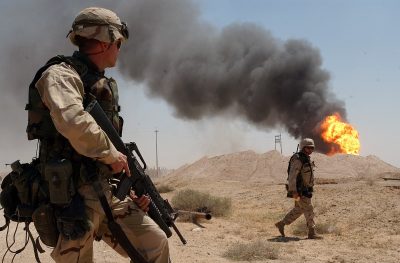Endless Wars: US Escalation to the East. Manlio Dinucci

All Global Research articles can be read in 51 languages by activating the Translate Website button below the author’s name (desktop version)
To receive Global Research’s Daily Newsletter (selected articles), click here.
Follow us on Instagram and Twitter and subscribe to our Telegram Channel. Feel free to repost and share widely Global Research articles.
***
Twenty years ago on March 20, 2003, the U.S. and the Coalition under their command attacked and invaded Iraq, which was accused of possessing weapons of mass destruction based on “evidence” that later turned out to be false. Secretary of State Colin Powell himself, who had presented them to the U.N. Security Council, would be forced years later to call his 2003 speech to the U.N. a “blot” on his record.
On March 20, President George Bush announced,
“On my order, coalition forces have begun striking to undermine Saddam Hussein’s ability to wage war. More than 35 countries are providing crucial support, up to and including the deployment of combat units. Every nation that is part of this coalition has chosen to take on the duty and share the honor of serving our common defense.”
The coalition under U.S. command included 30,000 Italian soldiers. Thus began the war that would kill more than a million Iraqis and cost the U.S., along with the war begun in Afghanistan in 2001, more than $14 trillion. The U.S. strategic goal was to control not only Iraq, but the entire Middle East.
March 2023 – “China-mediated Iran-Saudi Arabia deal sketches a new Middle East,” writes the Wall Street Journal, while the New York Times writes, “The deal between regional rivals highlights China’s growing economic and political importance in the Middle East and the decline of American influence.”
Unable to prevent the “decline” with political and economic tools, the U.S. and its allies are increasingly resorting to military ones. This includes the “landmark agreement with Australia and Britain,” announced by President Biden. It provides for the construction of a new fleet of nuclear attack submarines built by the U.S., Britain and Australia. This will make Australia the de facto tenth nuclear power tasked with holding China at gunpoint. The new nuclear attack fleet will operate not only in the South China Sea and the Pacific, but also in the Atlantic against Russia.
*
Note to readers: Please click the share buttons above or below. Follow us on Instagram and Twitter and subscribe to our Telegram Channel. Feel free to repost and share widely Global Research articles.
This article was originally published on byoblu in Italian.
Manlio Dinucci, award winning author, geopolitical analyst and geographer, Pisa, Italy. He is a Research Associate of the Centre for Research on Globalization (CRG).
Featured image: U.S. Army guarding Rumaylah Oil Fields, Southern Iraq, 2003. Photo credit: U.S. Navy via WikiMedia Commons

